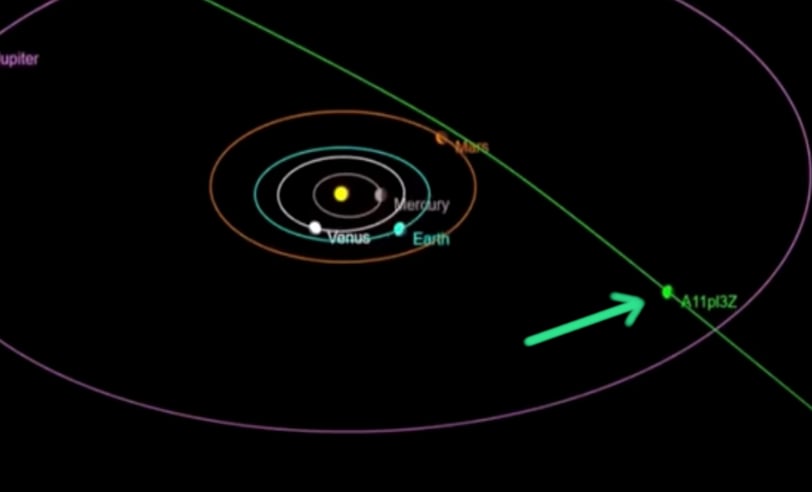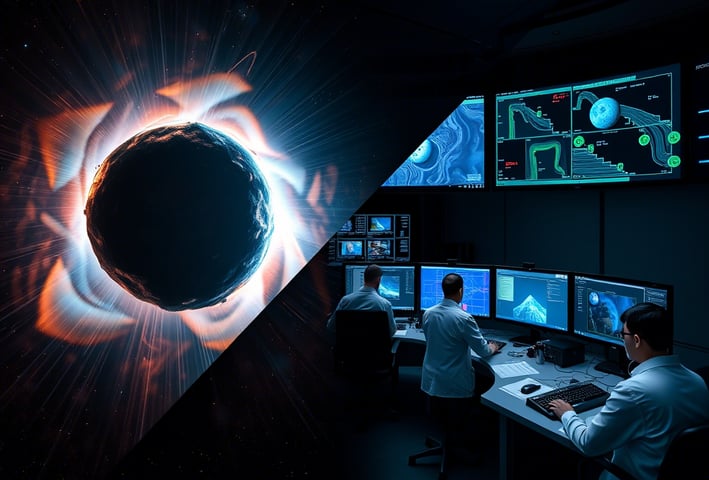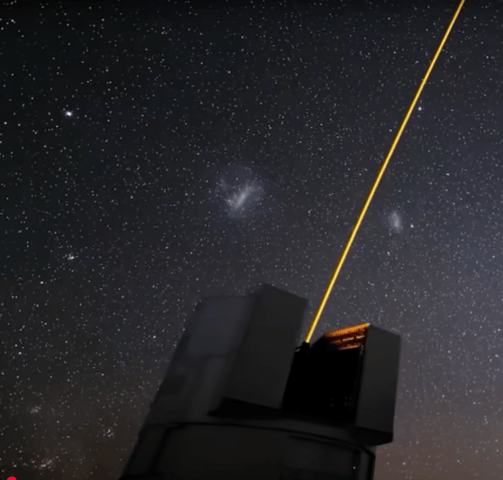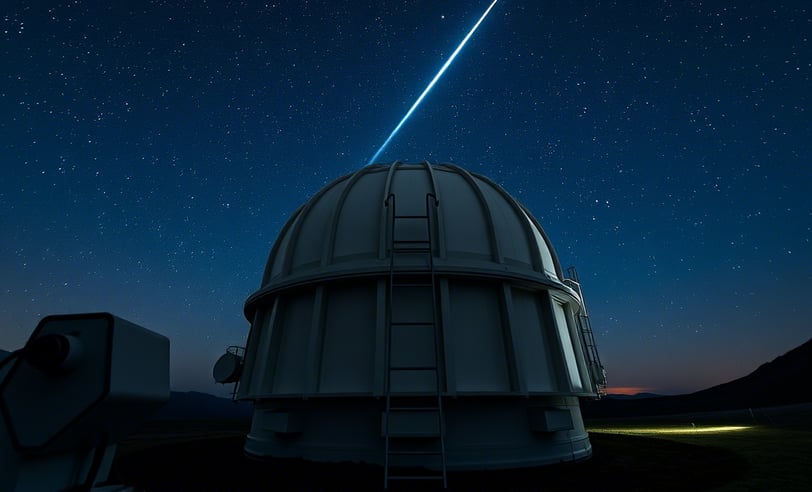The Cosmic Intruder: What the Interstellar Comet 3I/ATLAS Really Means for Us
3I/ATLAS, a weird object from outside our solar system, is in the headlines. Is it an indication of new discoveries, or is it something else? Let's work together to find out the truth about this comet from another galaxy. We'll separate fact from fiction and talk about what it implies for science, faith, and our place in the cosmos. Get ready for an adventure that will make you doubt everything you thought you knew about space!
AMAZINGSCIENCEUFOEXTRATERRESTRIAL LIFEPLANETS
Bringing Blessing
7/4/202511 min read


A Visitor from the Void


Unmasking the Intruder: Experiments and Verification
Sources Consulted
NASA Science Editorial Team. (2025, July 2). NASA Discovers Interstellar Comet Moving Through Solar System. NASA Science. https://science.nasa.gov/blogs/planetary-defense/2025/07/02/nasa-discovers-interstellar-comet-moving-through-solar-system/
Wikipedia contributors. (2025, July 4). 3I/ATLAS. Wikipedia. https://en.wikipedia.org/wiki/3I/ATLAS
This article was written based on extensive research from open sources on the internet, including news portals, social media, and discussion forums. The information presented here reflects the current state of the debate. The veracity of the claims and the interpretation of the facts are the responsibility of the original sources.
So, how did scientists go from seeing a little dot on a screen to proving that there was a comet between stars? It's a pretty interesting way for scientists to do detective work that involves astronomers from all over the world working together and using a lot of advanced telescopes. The early observations pointed to an interplanetary origin, but scientists needed more proof to be sure. They needed to be sure it wasn't merely a rare thing from our own Solar System.
Its path was the first clue. 3I/ATLAS is on a hyperbolic route, which means that its orbit around the Sun is not a closed loop like the orbits of most planets and comets in our Solar System. It's an open-ended curve, which is a clear hint that it's merely passing through. But the probe didn't end there. The next great question was whether it was a comet or an asteroid. This is an important difference since it tells us what the object is made of and where it came from.
Astronomers use spectroscopy, a method that looks at the light from an item to figure out what chemicals it is made of, to find the answer. Scientists could tell that 3I/ATLAS had a coma (a hazy cloud of gas and dust) and a tail, which are indications of a comet, by looking at the light that bounced off it. In fact, several telescopes, including the Deep Random Survey, the Lowell Discovery Telescope, and the Canada-France-Hawaii Telescope, saw the faint coma and short tail.
But not everyone was convinced right away. Alan Hale, who helped discover the famous Hale-Bopp comet, first said that there were no comet-like features. This shows how hard it is to see something so far away and faint. But David Jewitt and Jane Luu's later observations with the Nordic Optical Telescope gave much stronger proof. They said that 3I/ATLAS was "clearly active" and had a tail that spread out. Later, Miguel R. Alarcón and his team at the Teide Observatory in Spain found a tail that was at least 25,000 kilometers long! That's more than twice as wide as Earth!
Data to Check the Key:
Trajectory: Hyperbolic, with an orbital eccentricity of 6.30±0.15, which proves that it came from another star system.
Cometary activity has been confirmed by several observatories, which have seen a coma and a tail.
Spectroscopic investigation showed that the coma was reddish, like that of the preceding interstellar comet 2I/Borisov, which means that dust was present.
Size: The coma makes it hard to see the nucleus's actual size, although estimates say it might be as big as 24 kilometers across.
These tests and observations make things quite clear: 3I/ATLAS is a real interstellar comet that came from another star system and is made out of the same basic ingredients that made it. It came from a faraway part of the cosmos and is a time capsule. We're just starting to figure out what it holds.
A Messenger from Another World: What We Can Learn
The arrival of 3I/ATLAS is more than just a show in the sky; it's a treasure trove of scientific information. We can now look at a clean sample of material from another star system up close for the first time. This changes everything we thought we knew about how planetary systems come together and change throughout time. Scientists want to find out:
1. The Building Blocks of Other Worlds: Scientists can figure out the chemical makeup of the protoplanetary disk that 3I/ATLAS formed from by looking at the coma and tail of the comet. Getting a cake recipe from another galaxy is like this! It will let us know if other star systems have the same kinds of materials as ours or if there are more types of stuff out there. This could have a big effect on the search for life outside of Earth.
2. The Dynamics of Planetary Systems: What made 3I/ATLAS depart its home system? Was it a crazy dance of big planets, a close call with another star, or something else? We can learn more about the violent and changing forces that shape planetary systems by studying at its route and properties. This helps us learn more about how our own Solar System came to be and how it has changed throughout time.
3. How often do interstellar visitors come? The fact that three interstellar objects have been found in just a few years shows that these visitors may be more common than we imagined. This has sparked new interest in creating specific surveys and possibly a quick-response expedition to get up close and study these objects. Think about a spacecraft that could be launched on short notice to meet up with a comet from another star. The scientific benefits would be huge!
4. A Peek into the Unknown:
The best part of studying 3I/ATLAS might be that you never know what will happen. We don't know what we might find. Could there be organic molecules, which are the building elements of life? Is it possible that its makeup is very different from anything we've ever seen? This discovery is incredibly exciting since there are so many things that could happen.
"It is immediately clear that 3I/ATLAS is not in the same class of object as 1I/[ʻOumuamua] or 2I/Borisov," said David Jewitt, one of the top astronomers investigating 3I/ATLAS. This makes it seem like every intergalactic visitor is different and adds to the cosmic puzzle. It reminds us that the universe is a big, varied place with many surprises waiting to be found.
Not with a bang, but with a faint light in the Chilean night sky does the narrative of 3I/ATLAS begin. The NASA-funded Asteroid Terrestrial-impact Last Alert System (ATLAS) survey telescope in Río Hurtado, Chile, made the first discovery on July 1, 2025. This comet was not like any other; its path right away suggested something amazing. It moved at an incredible 61 kilometers per second (nearly 220,000 kilometers per hour!) compared to the Sun and followed a very strange course. It shouted "interstellar visitor."
Take a time to think about that: an object moving at such a high speed, free from the pull of our Sun, obviously shows that it came from a place very, very far away. The first interim name, A11pl3Z, was immediately replaced by its official name, 3I/ATLAS. The "3I" stands for the fact that it is just the third confirmed interstellar object ever found, after the mysterious "Oumuamua" in 2017 and the more comet-like "2I/Borisov" in 2019. This makes 3I/ATLAS a very valuable and unusual find.
The ATLAS system, which was made to find asteroids that are close to Earth, once again showed how important it is for protecting planets and discovering new things in space. But the story doesn't end with the first detection. Scientists looked through old observations to confirm that it was interstellar and get further information. The Zwicky Transient Facility and other ATLAS observations found sightings that happened before the discovery, going back to June 14, 2025. This longer observation time is a big plus because it helps astronomers get a better idea of the object's path and other features. Astronomers' pre-discovery observations are like uncovering old pictures of a famous person before they became famous.
Key Discovery Data: The ATLAS telescope at Río Hurtado, Chile, first reported it on July 1, 2025.
Pre-discovery Observations: The Zwicky Transient Facility (Ye Quanzhi) and ATLAS (Sam Deen) found it on June 14, 2025.
First Speed: 61 km/s (220,000 km/h) compared to the Sun. Official Name: 3I/ATLAS (also C/2025 N1 (ATLAS)).
Importance: This is the third confirmed interstellar object, which gives scientists a chance to investigate it like never before.
It's really important that this was found early and that there is data available before the discovery. We could only see 'Oumuamua as it was departing our Solar System, but we can see and analyze 3I/ATLAS for a much longer time. This gives us more time to run tests, gather data, and, in the end, learn more about this cosmic traveler. It's like having a rare animal come to your backyard, but this time you have weeks to watch it instead of just a few minutes.


The Journey Ahead: Where is 3I/ATLAS Going?
The Human Element: Voices from Earth


The findings of 3I/ATLAS has had an impact on more than just the scientific world. People from all walks of life have been fascinated by it, which has sparked curiosity, wonder, and even a little bit of existential awe. Let's look at some of the different points of view on this space traveler:
The Scientists: A Group of Excited People
3I/ATLAS is a dream come true for astronomers. We've never had the chance to investigate a clean sample of material from another star system before. The scientists' words show how excited they are.
"The discovery of 3I/ATLAS shows how powerful our survey telescopes are and how important it is for countries to work together." We are about to enter a new era in the study of interstellar space," - The ATLAS team says
"Every object in space is a different message from a star far away. 3I/ATLAS is going to be the most informative one yet because it can find things early and watch them for a long time," - Dr. Ye Quanzhi, from the University of Maryland
The Ufologists: A Sign of Something Bigger?
While scientists are looking into where 3I/ATLAS came from in nature, people in the ufology community are talking about it a lot. Some people think that the arrival of an item from another star system could be an indication of intelligent life outside of our own. Could it be a probe, a message, or maybe a spaceship that has been left behind? There is no scientific proof for these statements, but they show how deeply humans want to think that we are not alone in the universe.
You should be very skeptical of these assertions. The overwhelming scientific evidence suggests that 3I/ATLAS is a natural object, specifically a comet that was thrown out of its home star system. But this revelation shows that we need to keep looking for extraterrestrial intelligence (SETI). As we create better telescopes and survey methodologies, we may one day find something that nature can't explain. 3I/ATLAS is still a fascinating natural phenomenon that makes us think about how huge and magnificent the cosmos is.
In the end, finding 3I/ATLAS brings people together. It goes past cultural, political, and religious divisions and reminds us that we all live on a little, fragile globe in a large, intriguing cosmos. It's a call to look up, be curious, and go on adventures.
Picture this: a star-born wanderer, rushing through the vast cosmic ocean for thousands of years. It has traveled infinite distances, seen stars being born and dying, and now, despite all chances, it has come to our door. This isn't a story from the future; it's the amazing truth about 3I/ATLAS, the newest interstellar object to visit our Solar System. We believed we knew everything about our cosmic neighborhood, but a new enigma has emerged that makes us question what we thought we knew and what we thought was feasible.
People have looked up at the stars for hundreds of years and wondered what is beyond them. We have sent probes to planets that are very far away, used advanced telescopes to explore deep into galaxies, and even pondered going between stars. But to have a piece of another star system come to us? That makes a big difference. 3I/ATLAS isn't just a rock or a comet; it's a message carrier that brings secrets from a realm we can only imagine. It's a real link to the universe beyond our Sun, like a postcard from an alien home.
We'll separate the facts from the wild assumptions, look into the new discoveries, and hear from the clever individuals who are keeping an eye on it. We'll also speak about the wider ramifications of having this guest, such as how it could lead to scientific breakthroughs and the philosophical issues it raises. So, space travelers, get ready for a really exciting adventure!
What will happen next for our guest from space? Astronomers are in for a treat because 3I/ATLAS is presently on a voyage through the inner Solar System. Here is a chronology of its trip:
Closest Approach to the Sun (Perihelion): 3I/ATLAS will get closest to the Sun on October 30, 2025. It will be around 1.4 astronomical units (AU) away, which is just inside the orbit of Mars. At this time, its coma and tail will be at their brightest, and it will be most active.
Visibility from Earth: Ground-based telescopes should be able to see the comet until September 2025. After that, it will be too close to the Sun to see. It should show up again on the other side of the Sun by the beginning of December 2025, when it will be possible to see it again.
The Grand Exit: After getting very close to the Sun, 3I/ATLAS will keep going on its trip, back out into the empty space between stars. It will never come back to our Solar System, taking with it the knowledge it gained during its short stay.
Astronomers will only get to go on this trip once in their lives. They will use all of their resources, including ground-based telescopes and space-based observatories, to study 3I/ATLAS in ways that have never been done before. They will spend years looking at the information they gather, which will help us learn more about how planetary systems evolve and where we fit into the universe.
A New Era in Exploring the Universe
The discovery of 3I/ATLAS is more than just a headline; it's a major event in the history of astronomy. It reminds us that the universe is always changing and that there are always new things to discover. It's a call to keep looking into things, to expand our knowledge, and to never stop asking the big questions.
As we watch this intergalactic visitor move across space, we are not just seeing a comet; we are seeing the tale of the universe unfold. It's a story of how things came to be, how far apart things are, and how one thing traveled through the void. We learn more about ourselves and our role in the universe as we discover more about 3I/ATLAS.
Remember 3I/ATLAS the next time you look up at the stars at night. There are messengers from other worlds out there, and they have secrets that we are just starting to figure out. And don't forget that the adventure of exploring space is just getting started.
The Grand Entrance: How 3I/ATLAS Was Discovered




You might also like:
Contact Us


Want to know more? Our "Question and Answer" area is here to answer your questions and start important conversations.
Partners Products
Qualifies for free shipping offer.
Young Scholar Study Bible NKJV (Leather-soft Pink)
U$ 59.99
Amazing Illustrated Bible for Kids
U$ 59.99
Platinum Remnant Study Bible KJV (Genuine Top-grain Leather Gray/White) King James Version
U$ 129.99
Qualifies for free shipping offer.
Qualifies for free shipping offer.
Faith
Exploring the biblical truth and knowledge.
COMMUNITY
+55 95 98117-7630
© 2024 - 2025. All rights reserved.
Hamillton Rice Street 114 - Boa Vista- RR - BR






